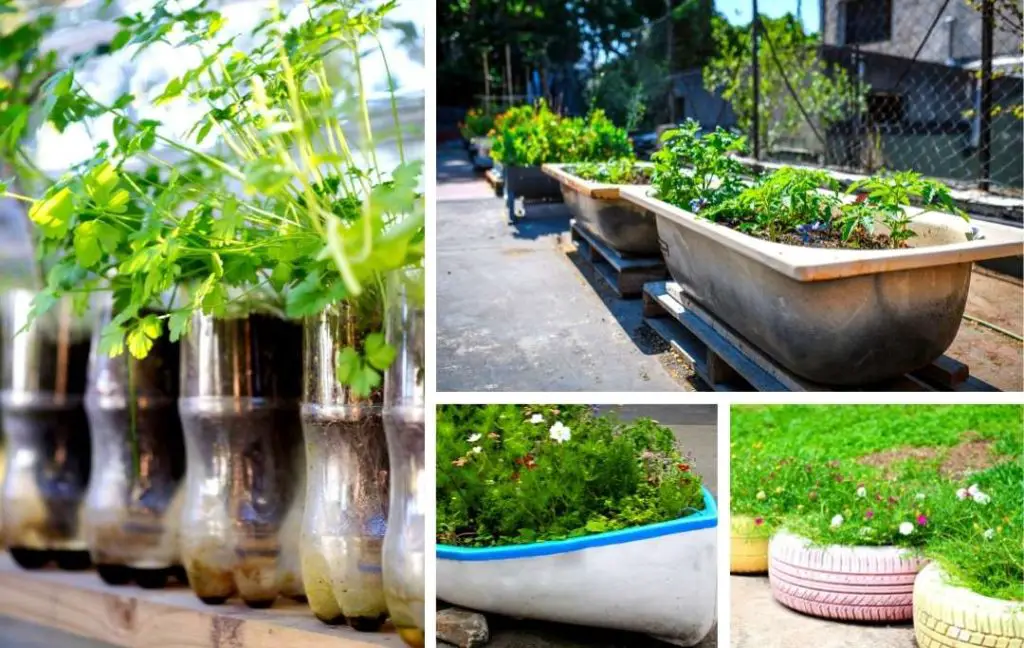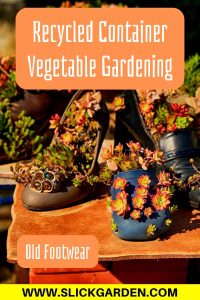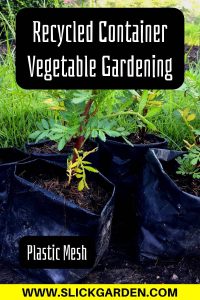Working in a garden full of the same old standard soil or plastic planter can be really boring. If you dream of breathing a little more life into your vegetables, just look at the ingredients in your home.
Many household items can be turned into a unique and creative planter from useless clutter or trash. As long as it can support the soil and allow drainage, you can use almost anything.
In fact, creating your own planter is not just a fun, hands-on project. It also helps the environment by recycling items that might otherwise be contained in landfills.

Recycling is one of the best ways you can improve your garden, regardless of its size or shape. When you pick up some of the things you throw away anyway and grow them into imaginative recycling plants for your garden, you’re helping the environment and preparing your home in the best way possible!
Consider Daily Use Things To Make Containers:
Anything that contains pottery makes a good container; literally anything! Unusual utensils include old pans, colanders, laundry baskets, chests of drawers, and everything, including kitchen sinks!
Metal items such as recycled milk mantles, coal buckets, or water tanks can create a beautiful rustic look. As with any vessel, you need to make sure that the container you want has enough drainage holes, or insert your own.
Bathroom Fixtures:

If you want the most unique garden in the neighborhood, toss in an old commode between your vegetables. One of the best and most conversation-starting planters are those made from old sinks, sink basins, bathtubs, and, yes, even toilets.
How To Use Bathroom Fixtures As Containers?
To turn your old bathroom fixtures into a planter, start by arranging the piece you have selected for drainage. All of these items should already have drains, so unlike most of the choices, you don’t have to worry about drilling.
Set The Drainage System:
However, the drains on bathroom fixtures are usually a bit too large for gardening needs, so to prevent water from rushing out too quickly, place a layer of rocks above the hole and along the bottom of your piece.
If the planter will be inside, you’ll need to place a mat or small bucket beneath the opening to catch any leaks. Once the fixture drainage system is in place, you are ready to get dirty. Just pack in your potting soil and choose the plants you want to use.
Vegetables To Grow In Bathroom Fixtures:
You can grow culinary herbs like coriander, basil, and thyme in sinks or basins. Other shallow-rooted vegetables like onions, spinach, broccoli, corn, and lettuce can also grow in these containers.
Old Footwear

Old work boots make ideal outdoor planters. Rather than tossing your old kicks in the trash, consider turning them into an exceptionally amusing home for a plant.
In particular, old work boots or rain boots work really well, not only because they’re large in size, but also because they’re sturdier than your average stiletto.
How To Grow Plants In Shoes:
To begin, first gather your footwear, potting soil, small rocks, and a drill (or a hammer and nails). The most important part of preparing the footwear and many of the other planters are drilling holes to allow for drainage.
Carefully use your drill to create small holes along the bottom of the shoe, a few inches apart. Place a few rocks along the bottom to help water drain and keep the holes from clogging. Next, pack in a layer of potting soil and start planting!
What To Plant In Footwear?
You can plant small herbs like mint, thyme, chives, oregano, and rosemary in the footwear. Be sure to water regularly. Plants in containers including old shoes tend to dry out quickly.
Tubs And Buckets:

We all have old buckets and plastic tubs, so instead of sitting them in a dusty corner, why not do something productive with them?
Using Tubs And Buckets As Containers:
Just wash each container thoroughly. Then cut holes in the bottom for drainage. Large buckets and tubs make the perfect home for plants because they can hold so much soil.
Therefore, you can plant several small plants or a large specimen that requires a little more space, such as dwarf tomato varieties. However, even if you have multiple drainage holes (and you should have a container of this size), it can be difficult to get all the water out when the tub or bucket is flat on the ground.
Use wooden planks to keep the container a few inches above the ground to avoid overfilling and root rot.
Vegetables To Grow In Buckets And Tubs:
Vegetables that are ideally suited for growing in tubs and buckets include tomatoes, eggplant, peppers, green onions, beans, lettuce, squash, radishes, and parsley. Because they hold enough soil that provides room for these vegetables to thrive well.
Old Furniture:

It’s easy to convert an old garden bench into an actual part of your garden. Many pieces of furniture can be turned into interesting and functional planters. In particular, chairs with wicker seats are ideal. However, anything with a seat that is relatively easy to cut through will do.
How To Use Old Furniture As Planters?
First, decorate the chair as you wish. Then make a hole in the seat so that a standard potted plant can slip into it without falling. If you are replacing a small dresser or something similar, first weatherproof it with sealant.
Then cut holes in the bottom drawers to allow air to flow. Next, make a few holes in the bottom of each drawer for drainage and fill them with soil. Make sure to tilt the drawers to show your plants to their full potential.
Maintenance:
If the dresser is too heavy or feels like it could move, secure it to an exterior wall or attach it to a tree or ground.
Vegetables To Grow In Old Furniture:
Vegetables that grow well in shallow containers include herbs, lettuce, cucumbers, carrots, and radishes. You can easily grow them in drawers.
Wooden Crates And Barrels:

This idea works exceptionally well for ancient or rustic gardens. Just make a few holes in the bottom of each container for drainage – a few inches above the ground if needed – then add soil and fertilizer. Just – your plants are ready to grow!
While a crate, keg, or barrel may look great on its own, adding several wooden containers to your garden makes a great theme. Try mixing and matching items of different sizes, or combine your garden with several large, strategically placed barrels.
Growing Vegetables In Wooden Crates And Barrels:
Crates are 12 to 18 inches deep. It can hold enough soil to provide room for perennials and medium-size vegetables like eggplant, peppers, and squashes.
Disposable Things:

Looking for the ultimate way to recycle, Use disposable equipment as plant containers! Milk jugs and 2-liter bottles; make the perfect home for your plants.
Growing Vegetables In Disposable Things:
All you have to do is cut the bottom of the container. Wash it thoroughly with soap and water. Make several small holes for drainage; Fill them with soil and plant your seeds.
As any ecologist will tell you, although these containers are made to be used once and thrown away, they are not biodegradable and can be reused many times in your garden.
Use As Plant Protectors:
Milk jugs also make excellent plant protectors! Use scissors to cut off the bottom of a jug and place the remaining upper portion firmly over your plant (cap removed) making sure to embed it in the soil so it won’t easily fall over.
Vegetables To Grow In Disposable Things:
Some plants do not require a lot of space in order to grow. Plants like basil, spinach, thyme, and green onions are very easy to grow in plastic bottles.
Crockery:

Dishes, pots, cookie tins, and baskets all have the best planting ability. Of course, in the case of glass or ceramic objects, the drainage must be obtained with proper drill bits and a certain amount of care. Like other recycling planters, just fill with soil and plant once your drainage holes have been dug.
Metal Utensils:
In addition to being the best use for old or cracked dishes, you can also turn used utensils and pans into planters. Use a metal drill bit to make holes, then paint your pots and pans, remove the handles or make other aesthetic changes according to your personal vision!
Inspect the metal before use:
However, not all materials are ideal. Cast iron can rust, and some other metals may react with minerals in the soil. Make sure you know what the container is made of before using it as a planter and inspect it thoroughly before starting your project.
Wheelbarrows:

It’s easy to turn this reliable tool into a permanent part of your nursery. And no matter what material your wheelbarrow bed is made of. Metal, wood, or plastic are all fine, although you will need to drill holes in anything other than wood.
All you need to do is find a place in your garden, stick the wheelbarrow firmly in the soil and fill the bed with dirt, maybe some fertilizer, and whatever plants you want to grow.
Vegetables To Grow?
You can grow any type of herb just as you would grow in the ground then water well.
Old Wooden Boat:

If you have an old wooden boat that will never visit the pond again, it will be a very cool and unique addition to your garden. Best of all, it doesn’t matter what the condition of the boat is.
Regardless of whether it has perforated and peeling paint or if you have just finished applying a new coat of varnish, this is sure to start a conversation
You can place it anywhere and it will stand out. You can easily tip it over the edge, fill it with soil and make it the center of your garden, or bury them all in the ground so that it looks like an ancient ship with an abundance of plant life. Practically any plant you consider adding to your garden will work here,
Suitable Vegetables For The Old Wooden Boat:
Any type of vegetables like ginger, garlic, carrot, cucumber, cabbage, pepper, broccoli, onion, and radishes can be grown in an old wooden boat.
Watering Cans:

You will not believe how easy it is to transform a simple watering can into a planter for herbs, flowers, and other small plants. In just moments, transform your boring patio or yard into something amazing with the watering can planter!
Conversion Of Water Cans Into Containers:
- Make a drainage hole in the bottom of your watering can using an electric drill. This will help you not overwater your plants.
- Place a few rocks; stones, and broken pieces of pottery in the bottom of your watering can (without blocking your drainage hole. This will also help promote drainage.
- Fill the watering can mostly full of soil.
Sacks:

Use old potting soil sacks for root veggies such as carrots or potatoes, and enjoy a final crop from summer growing bags by sowing a flush of winter salads into them once your tomatoes or peppers have finished.
Children’s Wagons:

Children’s wagons can be used as containers. Make drainage holes with the help of a drill. Line the wagon with a 1-inch layer of gravel to improve drainage and keep the holes from clogging.
Filling:
Add potting soil, stopping 1 inch below the wagon’s lip. Plant herbs with similar water and sun needs, and top with mulch. Then wheel to a sunny spot.
Vegetables To Grow:
Easy-to-grow basil, thyme, parsley, rosemary, and chives have similar water and sun needs and make a nice array when planted side-by-side in the wagon.
Plastic Mesh:

The big plastic mesh bags that dog food, cement, and fertilizer are packed in can also be used as planters. If you wash them out and roll down the tops before filling them with the gravel layer and your growing mixture.
Filling:
This should be a mixture of peat moss, potting soil with vermiculite, and some good quality compost to boost growth. You should position your containers before you fill them as they become too heavy to move around after filling, and leave some space between or around them so you can water and weed easily. Putting some gravel downs on these pathways will also help to repel snails.
Vegetables For Plastic Mesh:
These plastic bags are affordable for growing plants on patios and balconies. They are best for vegetables that do not have deep roots including tomatoes, zucchini, potatoes, and salad greens.
